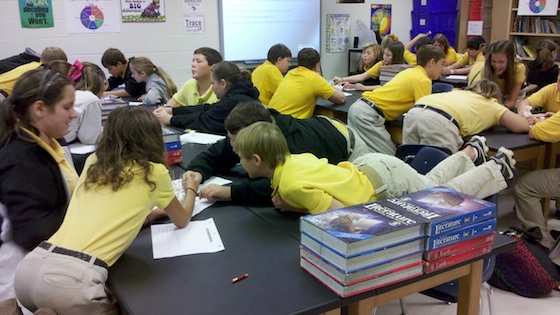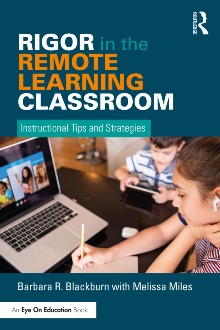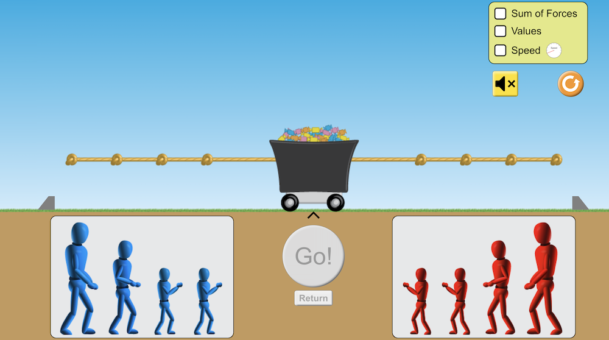Adding Simulations to Your Lesson Plans
By Barbara R. Blackburn, Abbigail Armstrong, and Melissa Miles

Barbara
One way students can gain deeper meaning about content is by experiencing the event or topic firsthand through simulations. Simulations, which require tactile or kinesthetic participation, provide another way for students to be actively engaged in their learning. Simulations allow students to experience another “world.”

Abbigail
In other words, they become part of a lab experiment, which allows them to make meaning in a different way, something that is particularly helpful for struggling students. Many computer simulations are available, but there are many simulations that can occur with little to no technology.

Melissa
For example, students can use simulations to practice using mass and water displacement to find the density of different objects like gold, wood and iron or work with sound concepts. They can also use simulations to test the accuracy of measurements like Pi or to understand concepts such as probability.
Other math and science simulations can include atomic interactions, conductivity, area builder, or geometric quadratics. An excellent source of math and science lessons is https://phet.colorado.edu/en/simulations.
Covid-19: If you are currently engaged in remote learning, you may be able to involve students at home in some physical simulations, depending on their age and the availability of materials and/or support from adults or older teens. Otherwise, bookmark these ideas for the future!
From coats of arms to child labor
Let’s look at simulations in more depth, using social studies and language arts as examples. Michael Pruitt, a teacher in North Carolina, uses this form of role play in his classes. For example, to help his U.S. history students gain an understanding of the flaws in the Articles of Confederation (1781-89) he has students build a Coat of Arms that represents their generation or their class. (You can explore Google Images for ideas.)
After dividing the class up into 13 groups of various sizes (original colonies), each group must brainstorm characteristics to describe their generation (you could change the task if desired). In a Parliamentary-style fashion, Pruitt leads them through a selection process, wherein each group only gets one vote, but all groups must agree upon the final criteria for the Coat of Arms. They soon discover that it is very difficult to come to a consensus when thirteen different groups with varying opinions and backgrounds are vying to have their voices represented.
Similarly, in his Civics classes, Pruitt uses role play to set up a factory simulation by convincing his students that they will be making a product together to sell and raise money (this could be something very inexpensive such as friendship bracelets, as long as the task can be divided into multiple steps). He first has them each make their own bracelet, but tells them that they are too slow, and they’ll never be able to make enough bracelets if they continue to work independently.

He asks them how the task can be broken into smaller parts (one cuts the string, one ties the first knot, three braid the strings, etc…). The students then break up to do just one specific part of creating the bracelet to make it faster (to demonstrate specialization and division of labor).
Pruitt then appoints a foreman to supervise the task and rush everyone. He then explains that some of the groups are in a regulatory state and introduces health and safety regulations on some groups, but not others (some groups must wear gloves, others have mandatory breaks or safety goggles to put on while completing their task).
To debrief, the teacher discusses the pros and cons of worker safety laws over productivity and employee happiness and follows by reading excerpts of Britain’s study of child factory safety in the 1800’s. (Resource)
Finally, in a sixth grade Language Arts class, students can even make the poem Casey at the Bat come to life by staging it and acting out the narrative. After assigning a narrator (or 2-3), students choose to role play Casey, Flynn, the umpire, the pitcher, the 5,000 fans, etc… Carefully listening as the poem is read aloud, each student steps into his or her assigned character and acts out the events that unfold, turning your classroom into a baseball stadium with jeering fans and a disappointed, embarrassed hometown hero.
Linking standards and engagement
Having students experience each of these settings allows them to acquire a deeper, more intimate understanding of the concept than if they had simply read about the subject matter. Just remember to plan your simulation so that it not only is engaging but also meets your standards.
You can help your students visualize almost anything in your cross-curricular classrooms, no matter the age or level of the student. Think outside of the box and turn written text into an activity your students can see and experience!
 Barbara Blackburn (@BarbBlackburn) has been named one of the Top 30 Global Gurus in Education in 2020. A former teacher, school leader and university teacher educator, she is a best-selling author of 21 books including Rigor is Not a Four Letter Word and Rigor and Differentiation in the Classroom: Tools and Strategies (Routledge/Eye On Education, 2018). Her newest book, with Melissa Miles, Rigor in the Remote Learning Classroom, will be out in September, 2020.
Barbara Blackburn (@BarbBlackburn) has been named one of the Top 30 Global Gurus in Education in 2020. A former teacher, school leader and university teacher educator, she is a best-selling author of 21 books including Rigor is Not a Four Letter Word and Rigor and Differentiation in the Classroom: Tools and Strategies (Routledge/Eye On Education, 2018). Her newest book, with Melissa Miles, Rigor in the Remote Learning Classroom, will be out in September, 2020.
A nationally recognized expert in the areas of rigor and motivation, she collaborates with schools and districts for professional development. Barbara can be reached through her website or her blog. Follow her on Twitter @BarbBlackburn.
Abbigail Armstrong (@draarmstrong) is the co-author of two books: Rigor in the 6-12 Math and Science Classroom and Rigor in the K-5 Math and Science Classroom, both written with Barbara. After teaching 7th and 8th grade mathematics for a decade, she joined Winthrop University in 2005 to teach in the Middle Level Education program. Abbigail is a skilled presenter and has shared her expertise at conferences and school districts internationally, nationally, and locally.
NBCT Melissa Miles co-authored Rigor in the 6–12 ELA and Social Studies Classroom and Rigor in the K–5 ELA and Social Studies Classroom with Barbara and worked with Barbara on several other books. With 18 years in middle grades classrooms, Missy was the Director of Educational Resources at a K-8 school in Charlotte, NC. She currently teaches ELA and is a certified member of the site visitation team for the “Schools to Watch” award.
Feature image: PhET Interactive Simulations


































